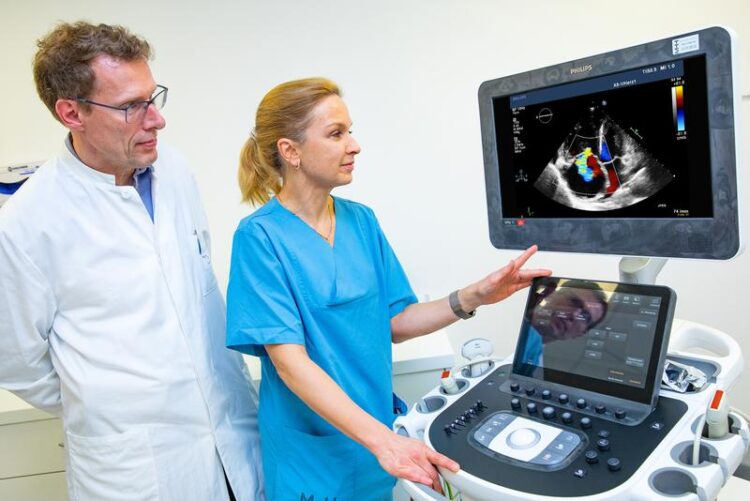Milestone in pulmonary hypertension therapy

Breakthrough in the treatment of rare pulmonary hypertension PAH: Professor Dr Marius Hoeper and Professor Dr Karen Olsson.
Copyright: Karin Kaiser / MHH
In pulmonary arterial hypertension (PAH), the small vessels in the lungs become increasingly narrow and obstruct the transport of blood to the lungs. A new drug can stop this change and possibly even reverse it.
Pulmonary arterial hypertension (PAH) is a special form of pulmonary hypertension. It occurs because the small arteries in the lungs narrow as a result of progressive changes in the blood vessels. As a result, the right side of the heart has to pump harder to get the blood to the lungs and the blood pressure in the pulmonary circulation rises. To date, more than ten drugs have been approved worldwide for the treatment of this disease, which mainly dilate the blood vessels. Nevertheless, only half of those affected by PAH survive the next seven years after diagnosis. New hope has now been given by an international clinical trial in which patients were treated with the new drug Sotatercept in addition to their existing therapy. “We were able to prove that Sotatercept not only decisively improves the symptoms, but also directly intervenes in the harmful remodelling processes of the lung vessels,” says Professor Dr Marius Hoeper, Deputy Director of the Department of Pneumology and Infectious Diseases at Hannover Medical School (MHH), which supervised the study as the lead centre. The results have been published in the New England Journal of Medicine, a leading international medical journal.
Sotatercept blocks switch for formation of new endothelial cells
PAH is a rare disease, but it is very serious. It mainly affects women between the ages of 30 and 60. Diagnosis is difficult because symptoms such as shortness of breath, fatigue, swollen feet, chest pain, or circulation problems are confused with those of other heart and lung diseases. Because the chronically elevated blood pressure in the pulmonary circulation also puts a strain on the right side of the heart, PAH not only leads to limited physical activity, but also to right heart failure (cardiac insufficiency), heart failure and reduced life expectancy. The cause is a malfunction in the small arteries of the lungs.
The small blood vessels in our body that lead from the heart to the lungs are constantly being remodelled: Cells of the inner layer of the vessels die off and new endothelial cells grow back. In PAH, these remodelling processes within these arterioles are out of balance. More endothelial cells are formed than die. Instead of a single layer of endothelial cells, new layers of endothelial cells accumulate on top of each other in the inner surface of the vessels and the vessels become narrower. The biological switch for the formation of new endothelial cells is a protein called Activin. Sotatercept binds to its surface as a so-called ligand. Thanks to this “ligand trap”, the Activin function is blocked and the pathological signal transmission is interrupted. “With Sotatercept, we are intervening in the fundamental mechanisms of vascular regulation for the first time ever in medicine,” Professor Hoeper emphasises.
Pulmonary hypertension decreases significantly
More than 320 people with PAH from 20 countries took part in the study. More than half of them suffered from severe symptoms despite maximum therapy with three drugs. The additional treatment with Sotatercept led to a significant improvement in breathing difficulties and general performance as well as a reduction in blood pressure in the lungs. At the same time, the risk of the patients’ condition worsening or dying decreased by more than 80 per cent compared to standard therapy. “Some of our study participants were able to leave the intensive care unit after treatment with Sotatercept and resume their professional activities,” reports Professor Dr. Karen Olsson, senior physician at the MHH clinic and co-author of the study. “We were even able to take patients off the transplant list who were already scheduled for a lung transplant.”
In most cases, pulmonary hypertension decreased significantly, and in some study participants, pulmonary hypertension even regressed completely. “This observation, combined with our experimental data, suggests that Sotatercept not only stops the growth of endothelial layers, but also partially regresses these pulmonary vascular changes,” notes Professor Hoeper. “However, the scientific proof of this is still pending.”
In cooperation with the MHH Paediatric Clinic, the researchers are also investigating the extent to which children with PAH benefit from the therapy. Another study will clarify how Sotatercept administration affects adults who have only recently been diagnosed with PAH and in whom the vascular changes are not yet so advanced.
An application is now being made for approval of Sotatercept for PAH therapy. The drug could be launched in Germany next year.
SERVICE:
The original paper „Phase 3 Trial of Sotatercept for Treatment of Pulmonary Arterial Hypertension“ can be found here: https://pubmed.ncbi.nlm.nih.gov/36877098/
For further information, please contact Professor Dr. Marius Hoeper, hoeper.marius@mh-hannover.de, phone (0511) 532-3537.
https://www.mhh.de/
Media Contact
All latest news from the category: Health and Medicine
This subject area encompasses research and studies in the field of human medicine.
Among the wide-ranging list of topics covered here are anesthesiology, anatomy, surgery, human genetics, hygiene and environmental medicine, internal medicine, neurology, pharmacology, physiology, urology and dental medicine.
Newest articles

First-of-its-kind study uses remote sensing to monitor plastic debris in rivers and lakes
Remote sensing creates a cost-effective solution to monitoring plastic pollution. A first-of-its-kind study from researchers at the University of Minnesota Twin Cities shows how remote sensing can help monitor and…

Laser-based artificial neuron mimics nerve cell functions at lightning speed
With a processing speed a billion times faster than nature, chip-based laser neuron could help advance AI tasks such as pattern recognition and sequence prediction. Researchers have developed a laser-based…

Optimising the processing of plastic waste
Just one look in the yellow bin reveals a colourful jumble of different types of plastic. However, the purer and more uniform plastic waste is, the easier it is to…



